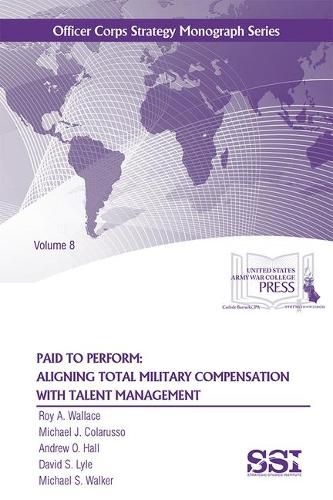Readings Newsletter
Become a Readings Member to make your shopping experience even easier.
Sign in or sign up for free!
You’re not far away from qualifying for FREE standard shipping within Australia
You’ve qualified for FREE standard shipping within Australia
The cart is loading…






Transforming the U.S. military's personnel management system is critical to long-run American national security interests, particularly as increasingly capable peer adversaries emerge. Talent management is critical to confronting these threats, particularly in an austere fiscal environment. This transformation cannot take place in a vacuum, however. As an extensive body of labor economics literature makes clear, total compensation management is an integral part of talent management. As the military changes the way it accesses, retains, develops, and employs its people, so, too, must it change the ways in which it compensates them. However, the current compensation system, rooted in industrial-era labor management practices, has outlived its usefulness. It is not linked to defined organizational outcomes, rests upon an ineffectual evaluation system, and does little to incentivize performance. Designed to complement an "up or out" personnel system that treats people as interchangeable parts, it has been rendered obsolete by dramatic changes in the American labor market, fiscal constraints, technological advances, and the changing nature of information age work. Using the Army's officer corps as a case study upon which a wider compensation model can be built, a system is proposed that integrates redesigned basic pays and pensions, "monetizes" nonpay benefits, and provides additional performance incentives in critical positions demanding organizational productivity.
Audience: Personnel managers, human resources and benefits program department heads, military command leaders overseeing active duty commissioned officers, and armed forces reserve commands, plus compensation analysts, labor lobbyists, and economists may be interested in this work. Additionally military members interested in advancing in their military careers, Reserve personnel, and ROTC students may also have an interest in this work.
Related Products:
Starting Strong: Talent-Based Branching of Newly Commissioned U.S. Army Officers can be found here: https: //bookstore.gpo.gov/products/sku/008-000-01184-2
The Future Security Environment: Why the U.S. Army Must Differentiate and Grow Millennial Officer Talent is available here: https: //bookstore.gpo.gov/products/sku/008-000-01197-4
The Armed Forces Officer can be found here: https: //bookstore.gpo.gov/products/sku/008-000-01234-2
How We Fight: Handbook for the Naval Warfighter is available here: https: //bookstore.gpo.gov/products/sku/008-000-01149-4
$9.00 standard shipping within Australia
FREE standard shipping within Australia for orders over $100.00
Express & International shipping calculated at checkout
Transforming the U.S. military's personnel management system is critical to long-run American national security interests, particularly as increasingly capable peer adversaries emerge. Talent management is critical to confronting these threats, particularly in an austere fiscal environment. This transformation cannot take place in a vacuum, however. As an extensive body of labor economics literature makes clear, total compensation management is an integral part of talent management. As the military changes the way it accesses, retains, develops, and employs its people, so, too, must it change the ways in which it compensates them. However, the current compensation system, rooted in industrial-era labor management practices, has outlived its usefulness. It is not linked to defined organizational outcomes, rests upon an ineffectual evaluation system, and does little to incentivize performance. Designed to complement an "up or out" personnel system that treats people as interchangeable parts, it has been rendered obsolete by dramatic changes in the American labor market, fiscal constraints, technological advances, and the changing nature of information age work. Using the Army's officer corps as a case study upon which a wider compensation model can be built, a system is proposed that integrates redesigned basic pays and pensions, "monetizes" nonpay benefits, and provides additional performance incentives in critical positions demanding organizational productivity.
Audience: Personnel managers, human resources and benefits program department heads, military command leaders overseeing active duty commissioned officers, and armed forces reserve commands, plus compensation analysts, labor lobbyists, and economists may be interested in this work. Additionally military members interested in advancing in their military careers, Reserve personnel, and ROTC students may also have an interest in this work.
Related Products:
Starting Strong: Talent-Based Branching of Newly Commissioned U.S. Army Officers can be found here: https: //bookstore.gpo.gov/products/sku/008-000-01184-2
The Future Security Environment: Why the U.S. Army Must Differentiate and Grow Millennial Officer Talent is available here: https: //bookstore.gpo.gov/products/sku/008-000-01197-4
The Armed Forces Officer can be found here: https: //bookstore.gpo.gov/products/sku/008-000-01234-2
How We Fight: Handbook for the Naval Warfighter is available here: https: //bookstore.gpo.gov/products/sku/008-000-01149-4